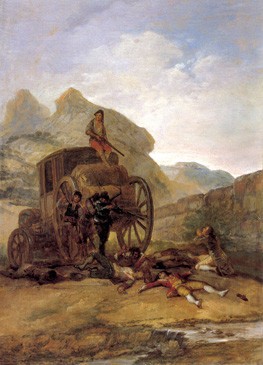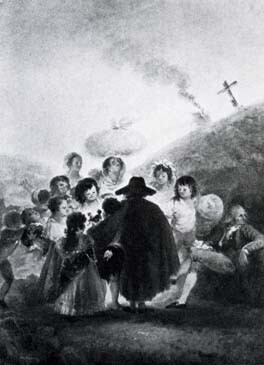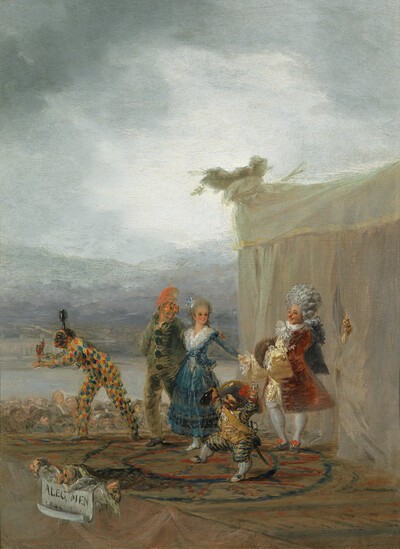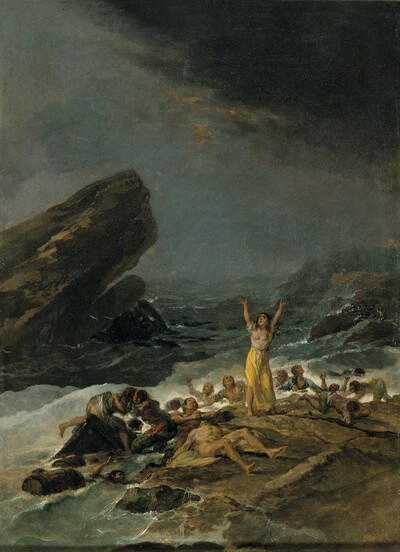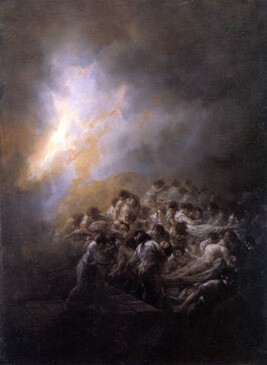- Cronología
- 1793 - 1794
- Ubicación
- Abelló Collection, Madrid, Spain
- Dimensiones
- 50 x 32 cm
- Técnica y soporte
- Oil on tin
- Reconocimiento de la autoría de Goya
- Undisputed work
- Titular
- Abelló Collection
- Ficha: realización/revisión
- 29 Apr 2010 / 14 Jun 2023
- Otros títulos:
-
Attack on a Coach (Ataque al coche)
Bandits Holding Up a Stagecoach
El asalto de ladrones
This work came from the collections of the Count of Adanero and the Marquis of Castro Serna.
This work forms part of the group of small-scale paintings that Goya painted during his stay in Cádiz between 1792 and 1793. These paintings afforded him the opportunity to give free rein to his creativity.
In the middle of a rocky landscape, a group of four bandits have just attacked a stagecoach. Two of them are looking around to see if anyone is coming, one of them perched atop the coach. Another bandit is stabbing one of the travellers as he lies on the ground. A fourth outlaw holds a rifle, with which he is about to shoot another traveller, who is in this case kneeling down, begging for mercy. Three bodies strewn across the ground complete the scene.
This same subject had already been dealt with by Goya in a painting made for the Duchess of Osuna (Stagecoach Hijacking), which the artist described as follows: "It shows some thieves who have attacked a stagecoach and after having overpowered and killed some of the travellers and an officer, who fought back, they are about to tie up a man and a woman". In the 1793 painting, Goya recycles several elements from the earlier work, such as the man keeping watch from atop the stagecoach and the traveller pleading with the outlaws, but in the later painting he has made the bandits even crueller.
This work shows Goya's interest in something which was all too common an occurrence in Spain at the time, especially in the mountains of Andalucía: banditry. He emphasizes the ferocity of these characters, who in popular imagination had taken on a positive, almost legendary aura, quite unlike their real character and the violence of their actions. Public interest in this theme gave rise to another work, similar to that of Goya: the print by Marcos Téllez entitled Highwaymen (Salteadores de caminos), made at the end of the 1790s (National Library, Madrid).
For more information, see Strolling Players.
-
Goya y el espíritu de la IlustraciónMuseo Nacional del PradoMadrid1988from October 6th to December 18th 1988. Exhibited also at Museum of Fine Arts, Boston, January 18th to March 26th 1989; The Metropolitan Museum of Art, Nueva York, May 9th to July 16th 1989, Madrid curator Manuela B. Mena Marqués, scientific directors Alfonso E. Pérez Sánchez and Eleanor A. Sayrecat. 20
-
Goya. El Capricho y la Invención. Cuadros de gabinete, bocetos y miniaturasMuseo Nacional del PradoMadrid1993from November 18th 1993 to February 15th 1994. Exhibited also at the Royal Academy of Arts, London, March 18th to June 12th 1994 and The Art Institute of Chicago, Chicago, July 16th to October 16th 1994, consultant editors Manuela B. Mena Marqués and Juliet Wilson-Bareaucat. 40
-
Goya: Prophet der ModerneAlte NationalgalerieBerlin2005from July 13th to October 3th 2005. Exhibitied also at the Kunsthistorischemuseum, Vienna, October 18th 2005 to January 8th 2006, consultant editor Manuela B. Mena Marquéscat. 28
-
GoyaBasle2021p. 138
-
L'œuvre peint de Goya. 4 volsParís1928-1950p. 173, cat. 127
-
Vie et ouvre de Francisco de GoyaParísOffice du livre1970p. 169, cat. 327
-
BarcelonaPolígrafa1970vol. I, p. 293, cat. 347
-
L’opera pittorica completa di GoyaMilanRizzoli1974p. 106, cat. 279
-
Francisco de Goya, 4 vols.ZaragozaCaja de Ahorros de Zaragoza, Aragón y Rioja1980-1982vol. II, p. 79
-
Goya. El capricho y la invención. Cuadros de gabinete, bocetos y miniaturasMadridMuseo del Prado1993pp. 200, 201, 202, 203 y 206 (il.), cat.
-
Los mundos de Goya (1746-1828)BarcelonaLunwerg2008p. 239
